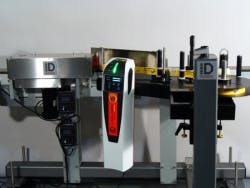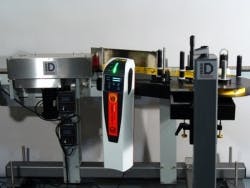Update: Laser identify siding modules and Just in time laser marking
Laser identify siding modules
Mukilteo, WA — Aluminum composite material, also known as ACM, is a common cladding material used to produce exterior and interior siding for commercial and industrial buildings. ACM typically consists of several thin aluminum sheets bonded to a thermoplastic center sheet, with options for additional coatings and paints applied for weather protection and fireproofing. The resulting material is lightweight yet robust and is easily shaped to fit around corners or other contours by folding the flexible thermoplastic center at the point where the aluminum sheets are seamed. A finished ACM panel system produces a modern look that is both functional and durable.
ACM is applied to the sides of buildings in large modular interlocking arrays, so if there is damage to the building, only the affected modules require replacement, not the entire siding face. Traceability of each ACM module is important so that the specific shape and location of each module can be archived within the construction documentation. Laser marking is an attractive option for adding required identification to these panels. The software-controlled process allows for simple automated data change for each individual piece, and, unlike labels or ink that can peel or scratch off, the laser creates a permanent mark that will withstand weathering in outdoor environments. Additionally, lasers offer a “greener” means of identifying products, without the use of labels, chemicals, inks, and other consumables and pollutants.
During recent processing trials, the Applications Labotatory at Synrad (www.synrad.com) demonstrated the CO2 laser’s ability to produce high-contrast marks on ACM. Using a 10 W laser with a galvo-based marking head, crisp, black marks were produced on the inside face of an ACM panel by ablating the exterior paint coating from the aluminum surface. The resulting mark, which includes human-readable text and a 1D bar code, encompasses an area measuring 82.55 mm x 76.2 mm (3.25 x 3 in.) and was marked in a cycle time of 33.48 seconds. Larger marking fields are possible, depending on the customer’s required working distance. Designed for easy integration, a CO2 laser and marking head can be mounted at almost any point in the manufacturing process after the ACM panels have been painted/coated.
With 25 years of innovative leadership and over 100,000 lasers in use worldwide, Synrad Inc. is the leading provider of sealed CO2 lasers to industry. For more information about Synrad products, visit www.synrad.com or e-mail [email protected].
Rofin’s lasers mark just-in-time marathon medals
Berlin, Germany — When the first runners passed the finish line at the 2009 Berlin Marathon, Klaus Huber of MSM Sportvermarktungs GmbH was still busy setting up the last parameters on his four Rofin laser marking systems. Time was crucial. Each minute, more of the 40,000 participants reached the finish line. A large number of them were then going to appear in his tent to have their medals marked with their names and personal running times.
Mobile laser marking in the tent
Several thousand medals were marked by MSM’s Huber, his partner Marion Hillenbrand, and 15 local freelance staff members that afternoon. The night before, they had installed the Rofin laser markers — an RS marker, two EasyMark systems, and a PowerLine F20 fiber laser — on folding tables in a tent beneath the timekeeper.
Huber and Hillenbrand started marking in the sports arena in 1999, when at the Swimming World Championship, they laser-marked 5,000 medal blanks with the data received from the timekeeping. Today, the company and its Rofin lasers work more than 70 sports events in Europe each year, requiring some unusual efforts from the user and manufacturer.
Lasers, laptops, and Lego
Just-in-time laser marking of medals is a complex task. The laser marking systems have to be transported, set-up, and put into operation under sometimes challenging circumstances. The entire system comprises many laptops and a complete Ethernet network connected to the timekeeping of the organizer. Many different kinds of software are needed to control the lasers, including tailored back-ends for the communication with various timekeeping databases. MSM workers normally have to install all this only a few hours before a major sports event, in a temporary tent at their own risk.
The laser marking process has to be fast and reliable; incorrect or failed markings cost time and the amount of blank medals available is limited. Medal specifications, including diameter, thickness, marking field, and fitting of the band, differ at each event.
The latest trend is to bond the endings of the band loop with a metal clip, which tends to impede the plane position of the medal if it is not bent. More often, Huber will get the medals only one day in advance and has to adapt the workpiece fixture, marking fields, and the laser parameters accordingly. When configuring the workpiece fixture, he relies on the childhood ‘technology’ of Lego. Experience has shown that the little bricks allow Huber to adapt all the parameters to each individual medal flexibly and fast.
Depending on the base material, the marking process is based on various physical processes. The most commonly-used version is the anthracite colored medal: due to the ablation of dark oxide layers, the finished marking is rich in contrast and clear. With light-colored and polished medals, the dark markings are generated by forming oxide partly by generating burrs on the surface.
Rofin provides service on Sunday night
Rofin has been assisting MSM since the beginning 10 years ago. On the whole, the laser systems cope very well with the weekly change-over and long journeys. Huber is aware that he can rely on the service network, even though he usually has to call the technicians during the weekend for them to solve problems without delay.
After the runners present their race numbers, all data from the time-keeping system is automatically downloaded to be marked upon their medals (left). Test marking for checking the correct positioning on the medal (right).
The first event abroad was the Zurich Marathon in 2001, which was the ultimate ‘acid test’. When Huber went to start the laser marker in the morning, he was met by a surprise. He had not considered the night frost, which caused the cooling water to freeze, and some critical parts in the processing chamber burst. This kind of damage cannot be repaired on site so Huber had to travel to Günding. When he arrived there, the service technicians began their work under extreme time pressure, and at 2:30 am, the laser was back in operation.
Up to 1500 medals per hour
At some big events, medals need to be marked every 2 to 3 seconds. During the peak period, up to 1,500 medals have to be marked per hour.
In Berlin, on a Sunday morning in September, everything is under control. MSM is well prepared for marking 8,000 medals. Several MSM employees take the medals, list the start numbers, and take them to the four laser markers in the tent, where one person is responsible for the correct positioning of the medal in the laser system and for unloading it. The other one takes care of the marking process and also sets the parameters of the number and the control of the runner’s data. Another member of staff is responsible for taking the medals out of the tent and using the loudspeaker to call out the name of the runner. If everything runs like clockwork, the team can hand out 20 medals per minute.
Small and flexible for on-site demands
In part, Huber and Hillenband are representatives of a growing band of laser users who operate their lasers in the field “on site”, away from laboratories and production halls. They are looking for tools that are compact, flexible and easy to use. ROFIN’s PowerLine F 20, which can be packed in an aluminum suitcase and transported without difficulty by aircraft, is one such tool.
For more information about Rofin products, visit www.rofin.com.

